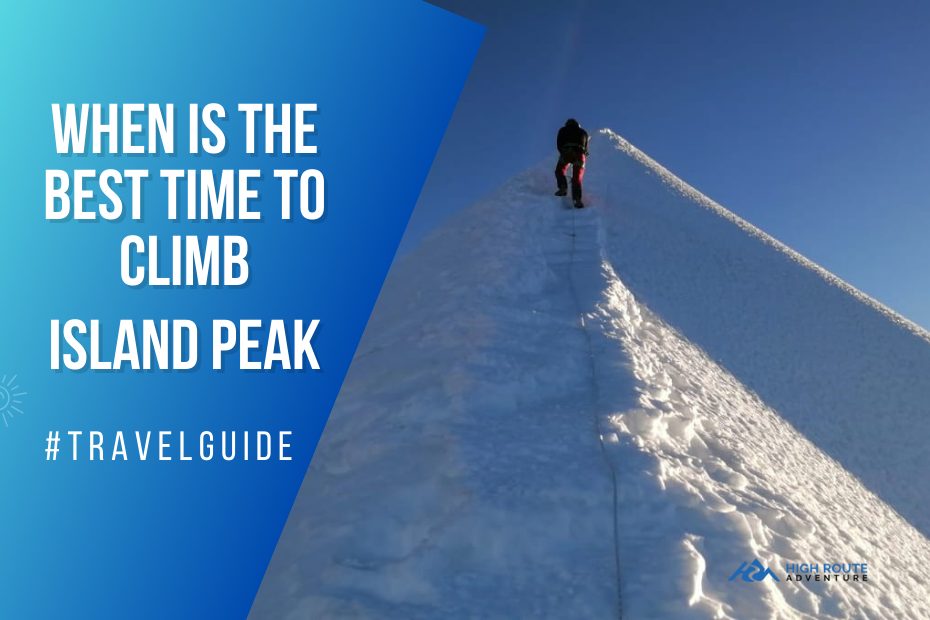Best Time To Climb Island Peak

At High Route Adventure, we get asked one question more than any other – when is the best time to climb Island Peak? Island Peak’s breathtaking 6,189-meter snow-capped peak attracts climbers to face its heights in order to enjoy 360-degree vistas of Makalu, Lhotse, Everest, and more Himalayan giants. However, the ascent that awaits the adventurers takes them to the edge of their physical and mental capabilities.
As veteran Island Peak Climbing leaders, our specialist mountain guides have experienced the peak’s climb in all seasons. Through extensive experience, we’ve curated the best trekking seasons based on the Most favorable weather, trail, and climbing conditions.
Discover spectacular landscape transitions from spring blossoms to autumn colors. Compare temperature ranges, trail traffic, highlights, and challenges of each season. Let our experts help you pick the ideal season to fulfill your mountaineering dreams.
Table of Contents
Island Peak Climbing in Spring
As the leading trekking partner, we highly recommend spring (March to May) as the optimal time for climbing Island Peak (6,189m). Moreover, Spring is the best time to visit Nepal. As the trails burst into bloom, the peak season offers stable weather, bearable temperatures, and clear mountain views – ideal conditions for a successful Island Peak ascent.
The Trails Come Alive
The floral explosion of rhododendrons, oaks, and more set Nepal’s trails painted in vivid red, pink, and white. One can relish trekking through blossoming forests and flower-filled valleys, often stopping to appreciate the colorful frames framing the Himalayan giants. The floral brilliance adds an extra vibrancy to the adventure.
Picture-Perfect Weather
Expect clear visibility, blue skies, and ample sunshine in spring. Daily temperatures average a comfortable 25°C but can drop to -15°C at higher elevations and nighttime. As for the peak’s summit, the temperature stays below the freezing level. Such stable conditions allow climbers to summit Island Peak safely. Our expert Sherpas also favor this season due to the predictable weather patterns.
Social Trails
As Everest Base Camp trekkers follow the same route, Island Peak climbers enjoy meeting fellow adventurers on the trail. The positive energy and company prepare trekkers mentally for the thrilling climb ahead.
Island Peak Climbing in Autumn
Autumn (September to November) is highly recommended as the optimal time for climbing Island Peak. With prime weather conditions and fewer crowds than in spring, our expert guides help climbers push their limits during the crisp and clear autumn months.
Refreshing Temperatures
While the monsoon rains bid farewell in early September, expect sun-filled days and cold nights for the rest of autumn. Daytime highs average a comfortable 20°C but can drop to -10 °C at higher elevations like the Island Peak base camp. Such refreshing temperatures motivate climbers to summit before sunrise.
Crisp Visibility
The monsoon rains cleanse the skies before retreating, exposing magnificent Himalayan panoramas. From Island Peak base camp, relish unobstructed views of Lhotse, Makalu, and Everest as they glow under the rising sun. The weather condition often provides clear visibility and relatively predictable situations.
Island Peak Climbing in Winter
The winter months of December through February bring freezing temperatures and heavy snowfall to Nepal’s high peaks. While popular trekking seasons stick to the warmer spring and autumn months, hardy mountaineers can brave the cold for a uniquely challenging and isolated Island Peak climb.
Frigid Temperatures Dominate the High Peaks
As winter sets in, the warmth drains rapidly from the Everest region mountains. Temperatures in lower valleys may only drop to -5°C overnight, with daytime highs around 12°C. However, the Island Peak summit soars well above 6,000m, where winds switch, and temperatures regularly drop below -15°C. Predicting exact temperatures is impossible, but the biting cold is a guarantee.
Climbing Difficulty Increases in Winter
Frozen trails, thinner air, and frequent storms make winter ascents more demanding. The route requires technical expertise in ropes, ice axes, and crampons. Even experienced climbers with proper protective gear can face life-threatening challenges. Island Peak is not advised for beginner climbers lacking winter mountaineering skills.
Discover Spectacular Tranquility on the Trail
The payoff for taking on a winter Island Peak climb is having the mountain almost entirely to yourself. Bright blue skies provide unobstructed views, and the sparkling landscape creates a magical wonderland. Without hordes of hikers, you can move at your own pace to soak up the scenery. The serenity amplifies the sense of accomplishment upon conquering the peak.
Attempt Early December for the Best Conditions
While no time is easy, early December brings relatively stable weather before the harshest cold and snow set in. Temperatures hover closer to average, and avalanche risks are lower. Starting the adventure during this month allows more flexibility if the summit attempt is postponed due to building storms. Regardless of when you go, being flexible with plans is vital.
Island Peak Climbing in Monsoon
The summer months of June through August bring the monsoon season to Nepal. While the periodic rainfall can hamper mountain views, the washed terrain reveals its brilliant green beauty. The monsoon offers a distinctly lush trekking experience for adventurers not discouraged by muddy trails. With proper preparation, attempting an early summer Island Peak climb is feasible.
Temperatures Fluctuate Around the Rain
Prior to the rainfall, summer heat and humidity dominate, with temperatures ranging from 18°C in lower valleys to around 10°C at higher elevations above 4,000m. Overnight lows average 2°C in lower regions and -2°C up high. Still, the cloud cover helps retain warmth better than the cold, clear nights of winter.
Rain Subsides in Stages from South to North
The monsoon rains sweep up from India, which means they arrive and depart at different times in various regions of Nepal. The Solukhumbu district with Island Peak generally has a drier early summer and wetter late summer. Rainfall is periodic rather than constant downpours. Mid-July tends to be the peak rainy season.
Target Early June for the Best Conditions
While some rainfall is inevitable, early June brings relatively drier and warmer weather. Wait any later, and muddy trails can risk the trek before even attempting the climb.
Packaging ample rain protection and waterproof outer layers is also wise when opting for a monsoon ascent. Crampons are likely unnecessary, but the other mountaineering gear is still handy.
Gear Checklist for Island Peak Climbing
Island Peak stands high at 6,189m, where temperatures fall below freezing, and ice and snow cover the route to the top. Attempting this daring summit requires proper protective equipment to avoid frostbite or worse. Use this essential gear checklist when packing for your Island Peak ascent.
| Climbing Equipment Ice Axe Crampons Climbing Helmet Climbing Harness Belay/Rappel Device Locking Carabiners – 3 Non-Locking Carabiners – 3 Mechanical Ascender 8mm Cord/16mm Tape Long Prusik Avalanche Transceiver Body Wear Waterproof Shell Jacket Waterproof Shell Trousers Expedition Down Jacket and Trousers Midweight Insulated Jacket Fleece Tops and Trousers Base Layers – Top and Bottom | Foot Wear Snow Gaiters Mountaineering Boots Down Bivvy Boots Head Wear Warm Hat Ski Goggles Hand Wear Fleece Gloves Mountaineering Gloves Expedition Mittens Camping Gear Down Sleeping Bags Foam and Inflatable Sleeping Mat Random Accessories Headlamps First Aid Kit Tool Kit |
How Challenging is it to Climb Island Peak?
At 6,189m, Island Peak towers above the landscape as an intimidating yet irresistible challenge for adventurous trekkers. Its soaring heights and slightly technical climbing terrain place it among Nepal’s most difficult undertakings. Determination, fitness, and proper preparation are essential to overcome the demands required to stand atop this Everest region prize.
Physically Demanding Trek to Reach the Climb
Simply accessing Island Peak is an achievement in itself. From Lukla airport, it takes 6-8 days of vigorous hiking just to reach base camp at around 5,000m. Trekkers carry packs up and down thousands of meters in elevation. Fitness, stamina, and trekking experience are key.
Steep Ice Climbing Presents Dangers
The real test comes with the climb from base camp to the narrow, airy summit. Guides fix ropes to help climbers wearing crampons scale the ice and rock headwall. Sudden storms or falling debris from climbers above also raise the risk. Proper protective gear and technique are a must.
Altitude Effects Cannot Be Ignored
Thin air above 6,000m causes most issues, resulting in symptoms like headaches, nausea, fatigue, and impaired reasoning. Climbers feel the altitude despite acclimatization treks. The pace is key to avoiding deadly complications like pulmonary or cerebral edema. Even match the hardiest can only spend limited time at the top.
Conquering Island Peak Earns True Badge of Honor
Incredible fitness, mental grit, technical skills, and pure determination are required to withstand the full physical and mental toll of Island Peak. Newcomers expecting just stunning scenery may be shocked. Earning the right to gaze out from its crowning glory is a genuine mountaineering achievement celebrated by all who accept the challenge.
Final Thoughts
As you can see, determining the best time to climb Island Peak requires weighing many factors, from weather and route conditions to personal skill level and preparation.
While the spring and autumn trekking seasons provide the overall best weather windows, pay close attention to finding optimal timing within those periods as well. Our decades of experience organizing successful Island Peak expeditions means we can provide unmatched guidance.
Contact us to secure your space in our Island Peak Climbings. As seasoned experts, our friendly team guarantees professional service, safety, guidance, and memories to last a lifetime.
Posted on








